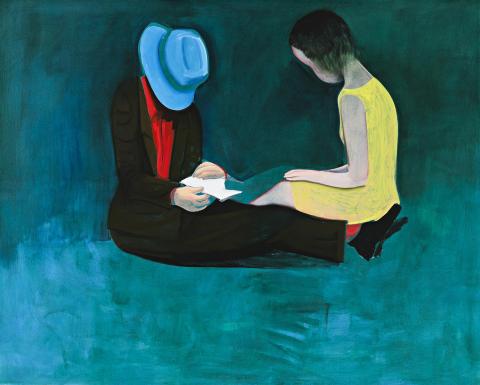THE LETTER, c.1968
CHARLES BLACKMAN
oil on canvas
172.5 x 213.0 cm
signed lower left: BLACKMAN
bears inscription on stretcher bar verso: AFTERNOON LIGHT
bears on label attached verso: 30
Private collection
Sotheby's, Melbourne, 19 August 1996, lot 156 (as ‘Afternoon Light’)
Private collection, Melbourne
Amadio, N., Charles Blackman Lost Domains, Alpine Fine Arts Collection, New York, 1980, cat 6.23, p. 98 (illus.)
During the late 1960s, Charles Blackman and his first wife Barbara returned to Australia after a lengthy sojourn in Europe and New York, settling afterwards in Sydney with a newfound wealth of literary and visual culture. A product of this rich cultural cradle, Charles Blackman’s oeuvre is eclectic and diverse, containing countless mysterious works accompanied by poetic titles. The artist was first to admit to the autobiographical symbolism inherent in his work. His painting was undoubtedly influenced by his personal experiences, the physical locations he had inhabited and the pictures he had seen. This is true for any artist; however few would be so ready to admit it. While an ocean of experience inspired Blackman’s images, these were rarely painted directly from reality. They seem instead to be removed from it, drawn from the realm of dreams, having been passed through a filter that both simplifies the image and endows it with a universal quality.
The Letter, c. 1968, is a large scale painting, executed around the same time as the artist’s ‘Park’ and ‘Garden’ paintings. As explained by Felicity St John Moore, in the National Gallery of Victoria’s extensive 1998 catalogue Schoolgirls and Angels, Blackman had recently returned from a trip to New York, a city that had filled his mind’s eye with experiences of urban parks.1 Renting a warehouse in Sydney, on Leswell Street, near Centennial Park, Blackman produced a number of bucolic scenes that captured the outdoor nature of Australian life.
Compositionally, this painting is closely linked to two others from 1968, Fête Champêtre and Déjeuner sur l’Herbe. All three feature a seated couple, their backs turned to the viewer, peacefully absorbed in each other’s company enjoying their natural environment. As indicated by the titles of these two works, the series of paintings display Blackman’s appreciation for French art of the mid-19th century. Like these bright, sunlit paintings, The Letter follows the same classical quality of composition, its static silhouettes reminiscent of the figures populating the banks of the Grande Jatte in Seurat’s Pointillist masterpiece. While the subject matter and composition may have been inherited from French Impressionism, the way in which Blackman approached them, in particular the flat application of paint and schematic design, was inspired by his discovery of the symbolist French painter, and ancestor of surrealism, Odilon Redon. Blackman found a particular affinity with the stillness of Redon’s work, it’s brooding long shadows and stark patterned surfaces.
A theatrical contrast between the couple, spotlit in the foreground, and the darkened sky against which they are placed, heightens the pictorial tension, intriguing the viewer yet revealing precious little of the narrative. Having attracted attention with its large scale, sumptuous colour and simplicity of form, Blackman invites the viewer to partake in this intimate scene. However, like the protagonist of Johannes Vermeer’s Lady Reading a Letter, the complete absorption of Blackman’s figures in their task of reading aloud and listening to the contents of a letter exclude the viewer from their private world. This symbiotic dynamic was one familiar to the artist, who had become used to reading to his wife, her eyesight having completely deteriorated by the 1940s. As St John Moore aptly writes, it was Barbara’s deteriorating vision that enabled Blackman to enter a literary and imaginary world, refining his observation and translation of a sense of poetic reality.
1. Moore, F. St. J. (ed), Schoolgirls and Angels, National Gallery of Victoria, Melbourne, 1993, p. 24
LUCIE REEVES-SMITH
